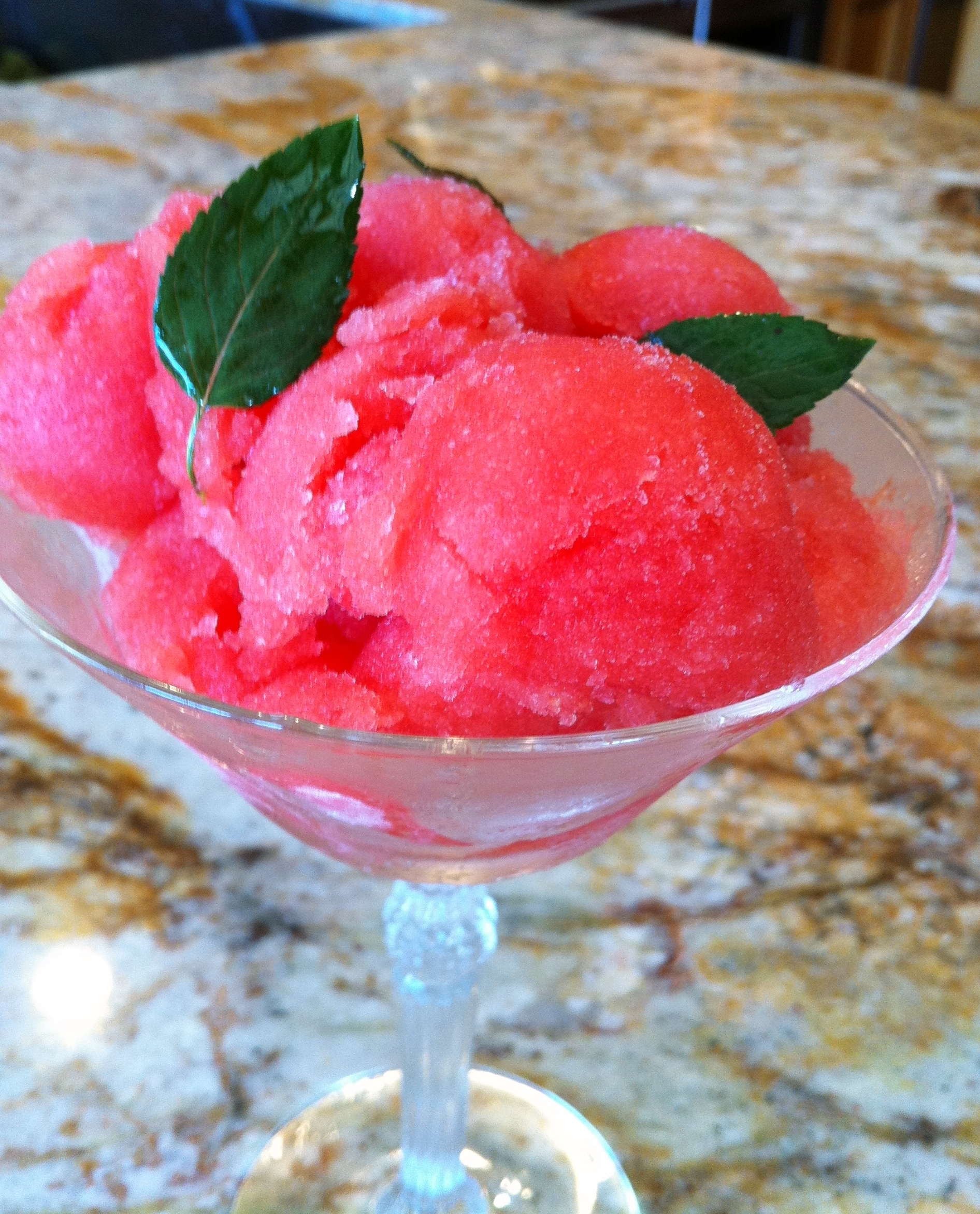Sandía Con Campari- Watermelon Campari Sorbet

Looking through my archives, found this delicious, refreshing dessert for your next dinner party.
The watermelon is native to Africa. We call it “sandía,” and consider it a Texas Mexican staple, as any Mexican-American family will tell you. Africa figures prominently in all Latina, Latino cuisines, and here in Texas our first encounter with Europeans was, simultaneously, the encounter with Africa. One of the four shipwreck survivors rescued by Native Americans in Galveston in 1528 was an African slave, Estevanico. Although he is an important historical figure who deftly communicated and negotiated both with both Native Americans and Europeans, Estevanico is not widely known. Historian, David La Vere, describes him, “the first great <non-native> explorer of North America was a black man — Estevan the Moor — who traveled more miles and saw more things than any other person in 16th century America.”
In this recipe the African watermelon meets up with the little beetle that lives in the Texas Mexican cactus.
“Sandía and Mexican lime are a natural blend in agua fresca, of course, but the addition of Italian Campari may give you pause. Fear not. It harmonizes beautifully. The right proportions and blending make this a truly complex bitter-tart-sweet, grown-up dessert. Glazed Spearmint adds contrast both in texture and color.
Italy’s Campari was already connected to Mexico and our Texas Mexican region because when the Italian, Gaspare Campari, created it in 1860, he looked to our Texas Mexican cactus, “nopal,” and the Cochineal beetle. Campari needed that deep, beautiful red color that you get when you crush the poor little Cochineal. The beetle lives in the cactus. It is in those white powdery specs that you see in the picture. Only in 2006 did Campari stop using Cochineal as a coloring agent.
created it in 1860, he looked to our Texas Mexican cactus, “nopal,” and the Cochineal beetle. Campari needed that deep, beautiful red color that you get when you crush the poor little Cochineal. The beetle lives in the cactus. It is in those white powdery specs that you see in the picture. Only in 2006 did Campari stop using Cochineal as a coloring agent.
Our ancestors, the Texas (Indians) Native Americans, had discovered and widely used the beautiful radiant red color. Until 2012 Starbucks used it to produce the lovely hue in its “Strawberry Frappucino.” (Farnham, 2012).
This recipe is from my book, Truly Texas Mexican: A Native Culinary Heritage In Recipes, avaliable at Barnes and Noble and Amazon
Recipe: (serves 4)
Ingredients
4 cups watermelon cubes
2 1/2 Tbspn Mexican lime juice
1 1/2 fl oz simple syrup (make simple syrup by combining equal parts sugar and water and heating until fully dissolved)
3 oz Campari
12 Spearmint leaves
For mint glaze:
1/2 cup sugar
1/2 cup water
1 Tbsp corn syrup
The method is really very simple. It’s actually the ratio/proportion and balance of the ingredients that is critical. So, just blend all the first four ingredients until totally smooth and freeze, stirring occasionally, until the sorbet freezes completely but still remains flaky. Scoop into sorbet dishes and garnish with the glazed Spearmint. I love this dessert.
To glaze the Spearmint leaves, heat the three ingredients in a small pan. Using a candy thermometer, heat gradually to the soft ball stage, 235º F, and remove from heat. When it cools down, dip the mint leaves, shake off excess and place them on a platter until you are ready to garnish. These add a wonderful finishing taste to the sorbet.
REFERENCES:
Farnham, A. (2012, March 26). [Web log message]. Retrieved from http://abcnews.go.com/blogs/business/2012/03/starbuggs-strawberry-frappuccino-colored-by-insects/
